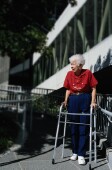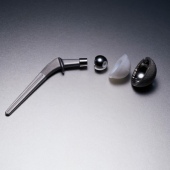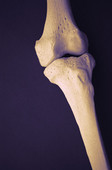| 
Falls Are Top Cause of Injury, Death Among Elderly
 SATURDAY, July 19 (HealthDay News) -- Falls are a leading cause of serious injury and death among elderly people in the United States, and most of those falls occur in the home, says the American Geriatric Society (AGS).
"There are many steps people can take to make their home safer for those who are aging. Something as small as using a night light in a dark hallway can prevent an elderly person from falling during the night," Dr. Cheryl Phillips, a member of the AGS, said in a news release. "Falls are so dangerous to this particular population, and there are easy ways to help avoid them," she added.
Phillips offered the following safety suggestions:
- Remove loose carpets and rugs, and put non-skid backing on rugs to avoid tripping.
- Wear shoes with firm, non-skid soles around the house. Wearing slippers or socks without some type of rubber grip on the bottom can increased the risk of falls.
- Place night lights in dimly lit areas, at the top and bottom of stairs, and in bedrooms and bathrooms.
- Remove clutter, boxes and low furniture from the house, and especially from near staircases.
- Install hand rails near any stairs in the home or backyard and check that existing hand rails are sturdy.
- Install grab bars near the toilet and bath tub, and no slip decals or a rubber mat in the tub or shower.
- Place contrasting strips at the edge of each step to clearly define where the step ends.
"I advise caregivers to walk through the home and check each room for potential dangers. Not all homes are the same, so caregivers should ask themselves what safety issues are unique to the particular house," Phillips said.
Each year, about one in three Americans aged 65 and older suffers a fall, and 30 percent of those falls cause injuries that require medical treatment. In 2005, almost 16,000 older adults in the United States died from falls, 1.8 million were treated in emergency departments, and 433,000 were hospitalized.
More information
The U.S. National Institute on Aging has more about older adults and falls.
|  |

Oral Drug Helps Prevent Clotting After Hip Replacement
 WEDNESDAY, June 25 (HealthDay News) -- Extended use of the oral drug rivaroxaban helps prevent potentially fatal blood clots after hip replacement surgery, British researchers say.
The risk of venous thromboembolism (VTE) is high after total hip replacement, and the risk can persist after a patient leaves the hospital. Current guidelines recommend patients receive a heparin-based preventive drug such as enoxaparin (Lovenox) for a minimum of 10 days, and up to 35 days, after surgery. However, this preventive treatment is not used much after patients leave the hospital, according to background information in the study.
The researchers at the London School of Medicine and Dentistry and the Thrombosis Research Institute compared the new oral antithrombotic drug rivaroxaban (Xarelto) with enoxaparin in the treatment of hip replacement patients.
In the randomized, controlled trial, 1,252 patients received 10 milligrams of oral rivaroxaban once daily for 31 to 39 days, followed by placebo injection for 10 to 14 days, while 1,257 patients received 40 milligram once-daily injections of enoxaparin for 10 to 14 days, followed by placebo tablets for 31 to 39 days.
The completed analysis of 864 patients in the rivaroxaban group and 869 patients in the enoxaparin group found that patients in the enoxaparin group were more than four times as likely to suffer deep vein thrombosis, nonfatal pulmonary embolism, or die than patients in the rivaroxaban group -- 9.3 percent versus 2 percent. Both groups had similar rates of bleeding events during treatment.
"Extended thromboprophylaxis with rivaroxaban was significantly more effective than short-term enoxaparin plus placebo for the prevention of venous thromboembolism, including symptomatic events, in patients undergoing total hip arthroplasty [replacement]," the researchers concluded.
The study was released online Wednesday by The Lancet and will be published in an upcoming issue.
"With superior efficacy, no compromise in safety, and a convenient once-daily regimen, rivaroxaban seems an obvious choice for simplified thromboprophylaxis after hip or knee arthroplasty [replacement]," Dr. John Eikelboom and Jeffrey Weitz, of McMaster University in Hamilton, Ontario, Canada, wrote in an accompanying editorial.
More information
The American Academy of Orthopaedic Surgeons has more about total hip replacement  . .
|  |

Heel Ultrasound Helps Detect Fracture Risk
 TUESDAY, June 24 (HealthDay News) -- By combining the results of a heel ultrasound with known risk factors for osteoporotic fractures, Swiss researchers were better able to assess which women faced a greater risk of hip fracture.
According to the study of more than 6,000 women, which was published in the July issue of Radiology, 6.1 percent of women in the group identified as high risk went on to have a hip fracture, while just 1.8 percent of the women in the low-risk group did.
"The results [of our study] show that this predictive rule is not only effective at identifying high-risk patients who should receive further testing, but also may be helpful in identifying patients for whom further testing can be avoided," said study author Dr. Idris Guessous, a senior research fellow at Lausanne University Hospital in Switzerland.
"Osteoporosis is a major public health issue expected to increase in association with the worldwide aging of the population," he explained. "The incidence of osteoporosis will outpace economic resources, and the development of strategies to better identify women who need and women who do not need to be treated is crucial. One potential approach is the use of the prediction rule combining heel quantitative ultrasound and clinical risk factors."
However, at least one expert thinks ultrasound technology has a way to go before it can compare to the current gold standard of bone density testing -- dual-energy X-ray absorptiometry (DEXA).
"This study could be useful; it could give options to populations that don't have access to the gold standard test, but at this point, there's nothing that's as good as the gold standard, DEXA," said Dr. Judi Chervenak, a menopause and bone health expert at Montefiore Medical Center in New York City.
The current study included 9,174 Swiss women between the ages of 70 and 85. The women were interviewed and asked about known osteoporosis risk factors, as well as socioeconomic factors. All of the women also underwent heel quantitative ultrasound testing. The average follow-up time was three years.
The researchers found that combining four clinical risk factors -- older age, history of fracture, a failed chair test or a recent fall, with a low heel ultrasound score was better at predicting the risk of a future fracture than ultrasound alone. A failed chair test meant that a woman couldn't rise from a chair three successive times without using the arms of the chair.
By using the two methods together -- what the researchers called the predictive rule -- they were able to better identify which women were at-risk for a fracture.
Of those women who had a fracture, 90 percent were identified as high risk using the predictive rule.
Chervenak said there are drawbacks to this method, however. She explained that there are two types of bone that need to be assessed: cortical, which is found in the hip, and trabecular, which is found in the spine. Ultrasound is good for assessing cortical bone, but will likely miss problems in trabecular bone.
Additionally, she said that there is no standardized ultrasound test yet, and different centers use different machines.
The bottom line, Chervenak said, is that she doesn't think bone density testing will change significantly any time soon. This is a "well-designed study, and they're trying to create an easy-to-use algorithm, but assessing risk is a skill, and each woman has to be assessed individually," she concluded.
More information
To learn more about bone density testing, visit the National Osteoporosis Foundation  . .
|  |
|